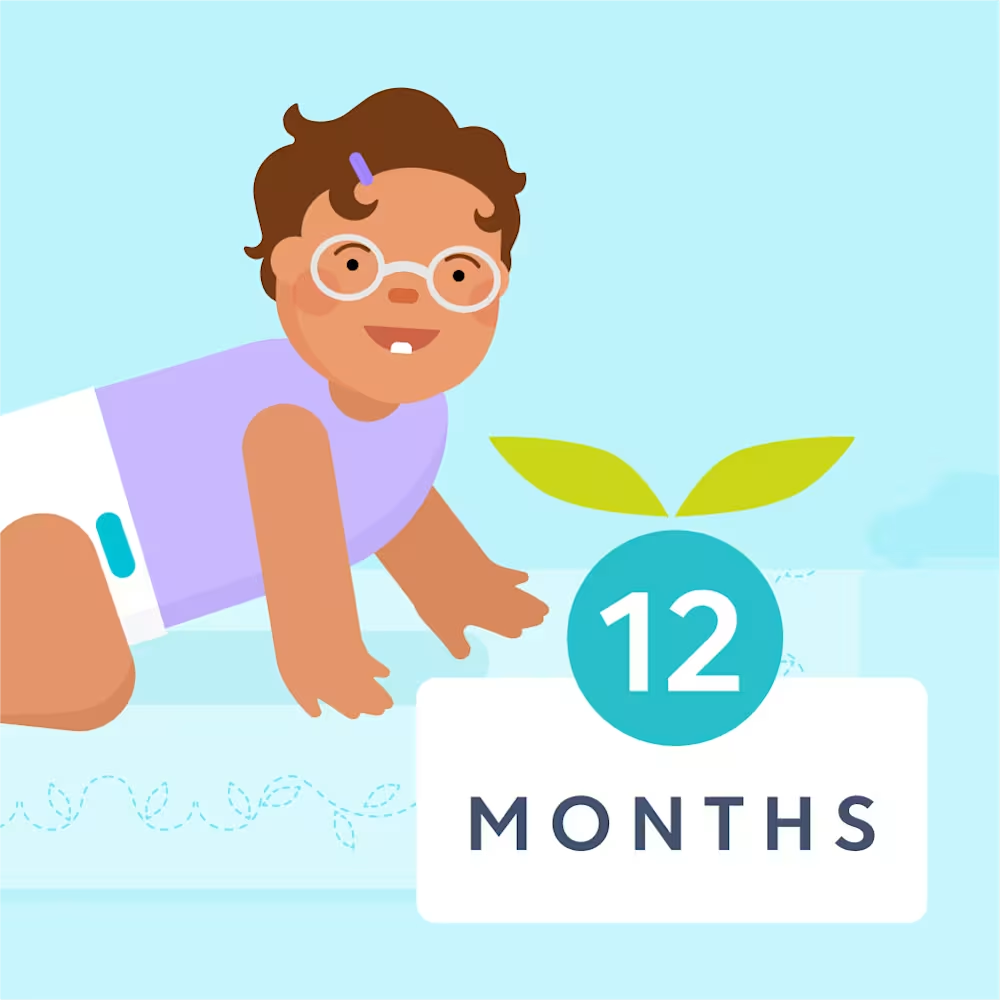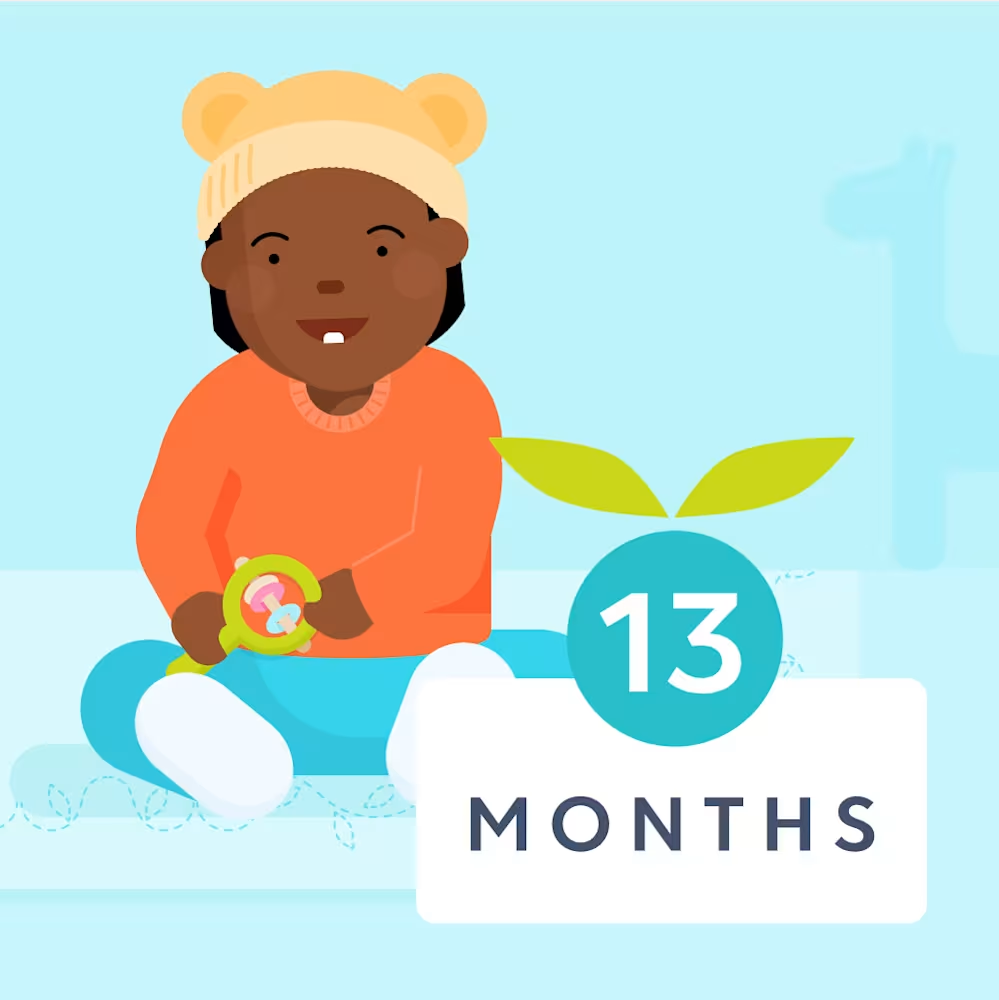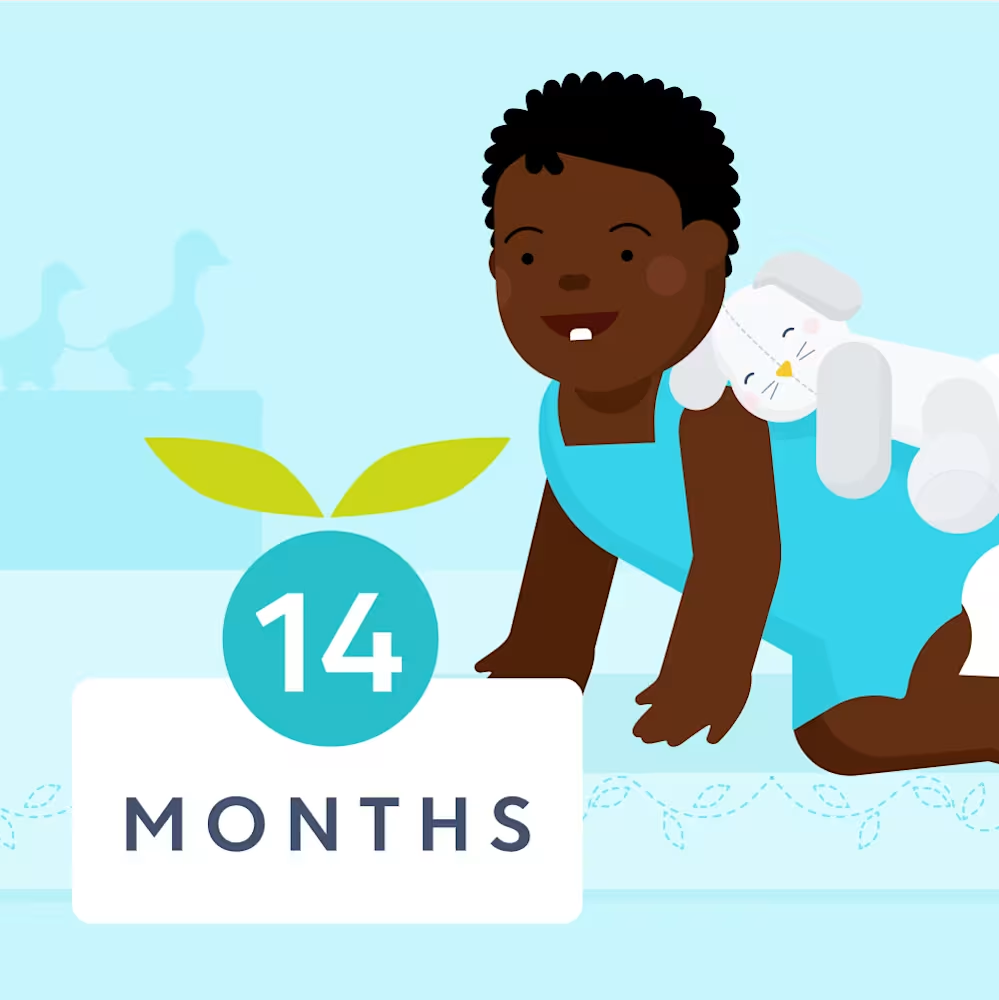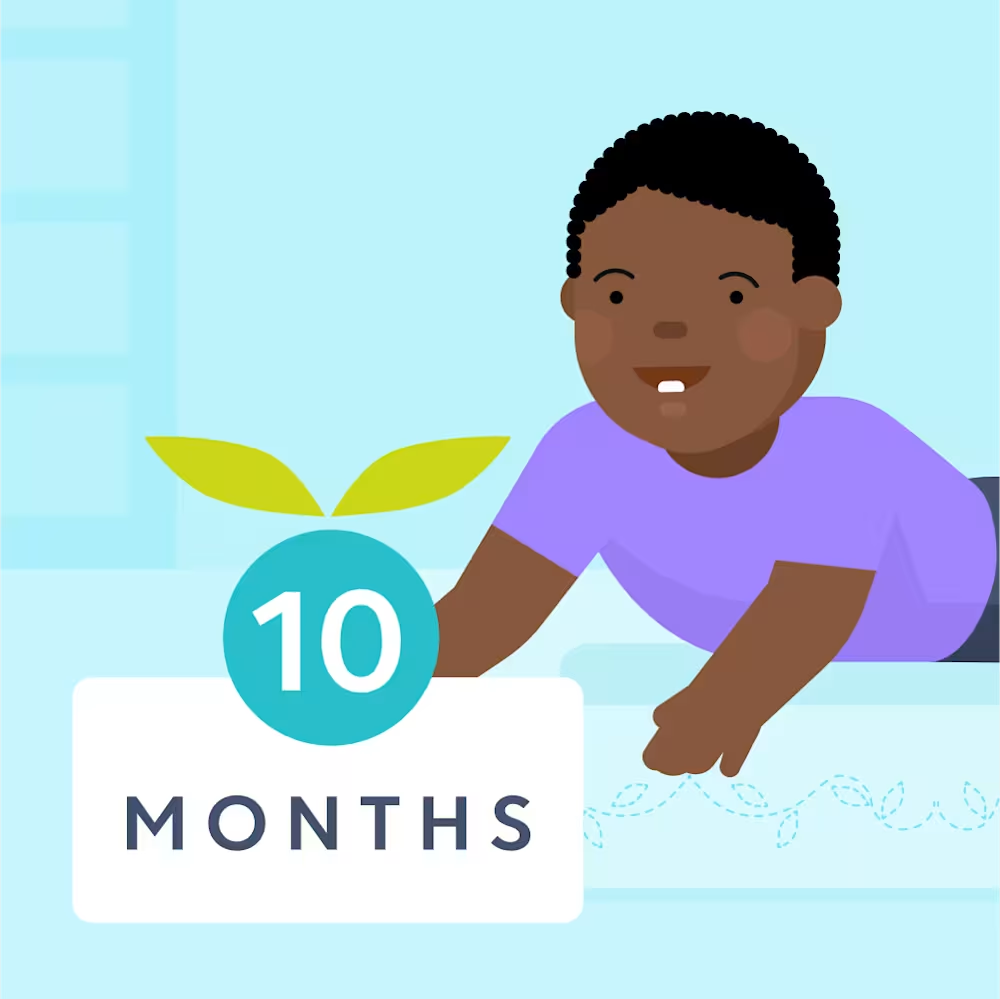11 month old baby milestones: Development, growth, speech, language
Updated Dec 29, 2025
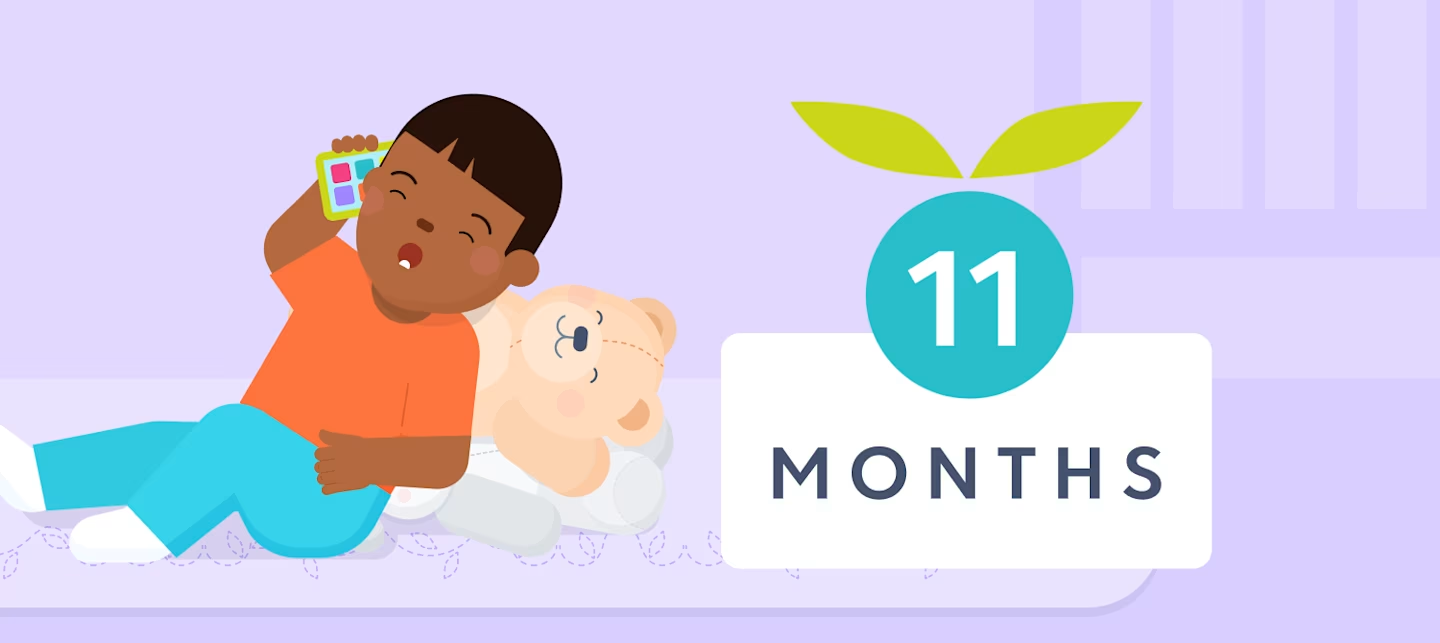
Welcome to the last month of your baby’s first year. While you may have all kinds of feelings about your child’s first birthday and the upcoming toddler stage, also know there are so many exciting things ahead. First steps and first words are commonly on the horizon at 11 months! Plus, your little one is likely already understanding some of the things you say.
In this article, we’ll take you through the milestones you can expect from 11 month old babies, give you a handy 11 month old development checklist, and provide useful tips to help ensure your little one is learning and growing as much as possible.
Editor's note
When we discuss babies and development at Huckleberry, we use their adjusted age (vs. actual age). Not all babies will reach these milestones at 11 months — and that’s normal. There’s a wide spectrum when it comes to how fast babies grow and develop. While many infants do reach these milestones at around 11 - 12 months, this isn’t always the case. If you have any concerns or questions about your child’s development, reach out to their pediatrician.
Table of Contents
11 month old baby milestones at a glance
Development:
As your child approaches their first birthday, they are learning and growing in so many exciting ways. Your baby at 11 months will likely be on the verge of saying their first word(s) and taking their first independent steps if they haven’t done so already! They’re commonly interacting with toys in new ways while also working on standing and cruising, in addition to crawling.
With so many 11 month milestones possible in this timeframe, it’s also helpful to remember that there’s a large spectrum of normal when it comes to child development. While it’s hard to be patient — you probably have your camera ready to capture these big moments at every turn — know that every kiddo is different and will develop in their own time.
Sleep:
Most 11 month olds will get around 13.5 hours of over a 24-hour period. This typically looks like 11 - 12 hours overnight with 2 - 3 hours of daytime sleep split over 2 naps. Little ones usually need about 3 - 3.75 hours of awake time before they’re ready for sleep again at this age.
Keep in mind these are just estimates and it’s best to pay attention to your child’s mood and energy levels when evaluating if they’re getting enough sleep. Every child is different!
Many babies can sleep through the night at 11 months. However, it can be tricky for some little ones to go 12 hours or more between their last night feeding and a family’s desired wake-up time. If you find that your child is waking very early (i.e. before 6:00 AM), you may consider offering an early morning feeding sometime between 3:00 - 5:00 AM. This can lengthen night sleep and help maintain positive sleep habits and is often preferred over starting the day very early.
Sleep can be tricky at this age and we’re here to help! If you’d like personalized sleep guidance for your little one, consider submitting for a sleep plan through . Our step-by-step plans are tailored to your child’s needs as well as your family’s goals.
Feeding:
As your baby approaches toddlerhood and their first birthday, solid food consumption will while their intake of formula and/or breast milk gradually decreases. However, breast milk and formula still provide important nutrition at 11 months and the majority of their calories per day will continue to be via liquid feedings. The American Academy of Pediatrics [] recommends around 24 ounces of breast milk or formula per day at this age. At 11 months, your baby’s typical day will likely include offering 2 - 3 solid meals as well as 3 - 5 nursing sessions or bottle feedings.
When it comes to solid foods, go ahead and offer a and textures to your little one at this age, within reason. Continue to avoid common choking hazards [] like tough or large chunks of meat, round or hard foods (candies, grapes, etc.), and hard raw vegetables (carrots, apples, etc.).
The AAP [] also advises you to wait until your baby’s first birthday to offer cow’s milk. It doesn’t have the nutrition (like vitamin C and iron) that infants need from breast milk or formula. Also, until after their first birthday as it can contain spores that are harmless to older children and adults but can cause botulism in babies. If you have questions or concerns about what to feed your little one as they increase their solid food consumption, consider reaching out to their healthcare provider for support.
At this age, your baby is likely getting better at using their hands [] and fingers to feed themselves. The goal is to move toward eating mostly finger foods at this age. You may even offer a spoon [] to your little one to experiment with. Practicing with utensils is usually messy, but it will help your child eventually get better at it. At this point, your baby will also likely be able to drink from an open cup [] with your help.
Growth:
Between 10 - 12 months, children tend to have a weight gain of about 13 ounces [] each month. Your little one’s birth weight will likely have tripled by their first birthday! They will also likely grow around 0.5 inches per month in height. Most infants grow 10 inches in their first year. Head size increases by about 0.5 inches each month in this age range too.
Note that it can be normal for your little one to grow more or less than at 11 months. At well-baby visits, your child’s doctor will chart their height and weight to check that they’re growing at a regular pace and can pinpoint any trends that need attention. If you have concerns about your baby’s growth at 11 months, consult their pediatrician.
11 month old development milestones
Physical development
Gross motor milestones
Crawling: Babies at 11 months are likely on the move using some form of crawling as they prepare to start walking in the coming months. a classic hands-and-knee crawling style or a variation, like belly crawling, bear crawling, rolling crawling, or bottom scooting.
Pulling to stand: Standing [] can be a precursor to walking and your little one may be able to use a sturdy stool or piece of furniture to pull themselves up onto two feet. Once your baby has gotten comfortable doing this, they may ” along the furniture. All of a sudden you may find your little one can get from one end of the couch to the other quite quickly when they master this skill!
Walking: Some children will be able to take independent steps at 11 months, though this is on the early side. Don’t fret if your little one isn’t there quite yet! There’s a wide when it comes to this big milestone, anywhere from 10 - 18 months [].
Sitting transitions: Babies at 11 months can usually get into a sitting position [] without assistance. They can also likely go from sitting to crawling or to lying on their stomach on the ground in a prone position.
Fine motor milestones
Object manipulation: 11 month fine motor milestones mean your child may be using their hands [] to do all sorts of new things like banging two objects together, putting items into containers (then taking them back out!), and letting go of objects voluntarily. At this age, children can often imitate scribbling too while holding onto something like a large crayon.
Pincer grasp: Pincer grasp (bringing the thumb and index finger together) usually develops at around 9 months, though sometimes it can happen closer to 12 months []. At 11 months your little one is likely using their pincer grasp to pick up all sorts of small objects and to feed themselves. Babies are fast and are likely to put all sorts of objects other than food in their mouths at this age, so be sure to keep their play space free of choking hazards.
Cognitive development
Exploring through touch: Do the simplest objects seem to captivate your baby at this age? By 12 months little ones are often shaking, throwing, dropping, pushing, and banging all sorts of things [] to see what happens! This exploration helps them learn about cause and effect [].
Using objects ‘correctly’: It can be so exciting to see your child learn about how the world works. They’ll start to communicate this understanding [] by using objects correctly — like drinking from a cup, pretending to dial a phone and putting it up to their ear to “talk,” and holding a brush up to their hair. At this age, they probably won’t be able to do these things well, but it’s still enjoyable to witness those light bulb moments of brain development that connect the object to the action.
Speech development
Gestures: Typical 11 month old speech milestones often include communicating with gestures [] like pointing, nodding, and waving.
Words: Typical 11 month speech development includes a child being able to say 1 - 2 single words they understand, like “dada” and “mama.” However, there’s a huge range of normal [] when it comes to talking so don’t fret if your baby isn’t there quite yet. As long as they’re experimenting with sounds and babbling with various intensities and pitches, these are good signs that they’re trying to talk.
Instructions: Babies at 11 months can often understand simple instructions [], especially with the aid of visual cues. This may look like holding your hand out and asking them to hand you a toy.
Comprehension: Language comprehension [] usually develops before a little one is able to talk. This means that at 11 months your baby may be able to understand a word you’ve said without being able to say the word quite yet. Some signs of comprehension include looking at the object when they hear the word or nodding “yes” or “no” when they’re asked a question.
Social development
Emotional development
Anxiety over being away from caregivers: As babies move from crawling to walking, or decrease depending on the child as they explore away from you. 11 month old emotional development often means children prefer their parents and regular caregivers over all others and cry when they leave. Little ones may additionally be shy or anxious [] around strangers at this point. This can be a tricky period to navigate as a parent and a little one, but rest assured separation anxiety tends to decrease at around 18 months.
Toy preferences: Children at 11 months tend to have favorite people and toys too. Around this age, a comfort object (also called a “transitional object” []) can help your little one feel safe and secure at bedtime or when temporarily separated from a caregiver.
11 month old development milestones checklist
Note that most children will hit these milestones at around 11 - 12 months, though there’s a wide spectrum of normal when it comes to child development. Don’t fret if your little one isn’t doing every single one of these things by the time they’re 11 months old. However, if you are concerned about your child’s growth or developmental delays when it comes to 11 month old milestones, reach out to their healthcare provider.
Does some version of crawling
Pulls to stand
May cruise along furniture
May take independent steps
Gets into a sitting position independently
Moves from sitting to crawling or prone position
Uses pincer grasp
Explores objects by banging, dropping, pushing, etc.
Begins to use items “correctly” (i.e. play phone)
Uses gestures like pointing, waving, nodding
May be able to say 1 - 2 words (often “mama” and “dada”)
Follows simple directions
Shows signs of language comprehension
Has a strong preference for parents/regular caregivers
May be shy or anxious around strangers or new caregivers
Prefers certain people and toys
What are 11 month old development red flags?
If your little one doesn't reach all of these milestones by 11 months, don't fret! There's a range of normal when it comes to development and growth stages. However, if you notice any of the following signs, check in with your child's healthcare provider to rule out any underlying issues [].
Baby isn't bearing weight on legs with support
Can't sit without help
Not making babbling sounds like "mamama" and "dadada"
Doesn't respond to their name
Doesn't look where you point
No interest in back-and-forth play
Doesn't transfer an object from one hand to the other
Doesn't recognize familiar people
Development tips for 11 month old babies
Tip | Why it helps | What to try |
|---|---|---|
Encourage movement | Building strength and coordination supports the development of skills such as standing, cruising, and walking. | Create safe spaces for movement indoors and outdoors. Place toys just out of reach to encourage crawling or reaching, or put toys on a couch to motivate pulling to stand. |
Consider longer awake times if naps are resisted | Nap resistance is often tied to timing, not regression — more awake time can help sleep come more easily. | If naps are a struggle, try extending wake windows to 3.5 - 3.75 hours. Avoid transitioning to one nap this early. |
Find more details below:
Tip #1: Encourage movement
A great way to help your little one build the muscle strength necessary for upcoming gross motor skills like walking and running is by (safely) letting them explore. Encourage them to move as much as possible by spending time outdoors and setting up safe play spaces indoors. Try activities like sitting your child on the ground with toys just out of reach to encourage them to reach and move toward the items. Alternatively, place toys on a couch to motivate your baby to pull to stand.
Tip #2: Consider longer periods of awake time if your baby’s resisting naps
If your child is , this may be a sign that they may need a little more awake time between naps or before bedtime. If this is the case, consider lengthening wake windows to 3.5 - 3.75 hours to see if that helps your baby fall asleep more easily during the day. At this age sleep issues like skipped or short naps often get chalked up to “nap regressions” or the , however, we often find these difficulties can be related to needing a schedule adjustment instead.
It’s also unlikely that your little one is ready for a 1-nap schedule at 11 months. Babies often transition to one mid-day nap between , though some daycare providers will move kiddos to a one-nap schedule .
Activities for an 11 month old baby
1. Try back-and-forth conversations
A great way to boost 11 month old language development is by talking out loud with your 11 month old, even if the conversation feels pretty one-sided right now. When they engage you by saying words or babbling, be sure to respond! This encourages conversation [] and boosts communication skills too. Continue to talk, read, and sing to your baby as much as possible too. Repetition and exposure to words are great for little talkers.
2. Offer foods with different textures
As your little one is becoming a more confident eater and eating more solid food meals per day as their first birthday approaches, they may be ready to at mealtimes. Up until recently, they may have only eaten so now is a great time to introduce textures that are a little harder, like roasted vegetables or cooked pasta. Expect lots of funny facial expressions at first as they get used to these foods. You can continue to advance as your child’s chewing and swallowing skills increase as well as their tolerance for unfamiliar textures.
Of course, always supervise your child while they’re eating and avoid such as raw vegetables, foods that are round or cubed, and crunchy or hard foods like popcorn and nuts. Tip #5: Tips for drinking from an open cup
3. Practice drinking from an open cup
It’s no secret that kids make big messes when they’re learning to eat, especially when they’re working on drinking from open cups. This is partly because splashing around in water is fun and also because this skill requires hand-eye coordination [] and strong mouth muscles.
To help your baby get better at drinking from a cup, consider letting them play with an empty cup so they can practice the motion of bringing it to their mouth without the risk of spilling. Also, try modeling drinking from a cup so they can observe how to correctly do so — little ones love to mimic at this age. When you do offer them water in a cup, limit it to 1 - 2 ounces at a time to avoid flooding the floor. Better yet, have your kiddo practice outside!
Caring for a sick 11 month old baby
By around 11 months, many babies are busy exploring and engaging more with the people around them. When they get sick — whether it’s a cold, ear infection, or another common illness — their curiosity and energy can take a temporary dip. That's normal! Here are some ways to help them feel better, especially before sleep times.
Keep them hydrated: Breast milk or formula is still their primary source of nutrition. If they’re not taking full feeds, try smaller, more frequent ones. If they're not interested in table foods while they're feeling under the weather, that's OK.
Relieve congestion: A cool-mist humidifier, saline drops, and gentle suction can help with stuffy noses. Clearing congestion before naps and bedtime can make it easier for them to rest.
Check fevers: Call your pediatrician if a fever lasts longer than 24 hours or repeatedly goes above 104°F (40°C) []. If your doctor gives the go-ahead, infant Tylenol or Motrin can be used. Avoid cough and cold medicines, which are not safe for babies.
Adjust sleep expectations: Sickness can mean more naps, shorter naps, or more nighttime waking. Follow their cues when possible and ease back into your regular schedule when they’re feeling better.
Offer comfort: Your baby might want more cuddles, rocking, or closeness — or they might prefer some space. Caring for a sick little one can be tiring for parents too. Lean on your partner or another support person when possible, especially if you get sick too.
When to seek help
If your child has a fever for more than 24 hours or it reaches above 104°F (40°C), call their doctor right away. These can be signs of a more serious infection or illness and it's best to rule out anything that needs medical attention.
In general, if something feels off or you’re worried about how your child looks or acts, it’s safest to check in with their doctor. And if you already talked to them but symptoms appear worse, that’s a good time to check back in too.
Takeaway: Development milestones for 11 month olds
Little ones learn and grow every day! In terms of 11 month gross motor milestones, children are likely working on skills like standing and cruising while continuing to crawl. Some babies are early walkers and may be taking independent steps already, but it’s perfectly normal if they’re not there yet. Children typically learn to walk between 10 - 18 months.
As your baby gets closer to their first birthday, they’re likely eating 2 - 3 solid food meals per day. Now is a great time to try offering various tastes and textures.
Your child’s first words are likely on the horizon if they haven’t said a word or two yet. Children can often say 1 - 2 words at 11 months, like “mama” or “dada.” Encourage 11 month old speech development by talking, reading, and singing to your baby.
These are general guidelines for development at 11 months. Rest assured there’s a wide spectrum of normal when it comes to baby milestones — it’s OK if your baby isn’t doing all of these things between 11 - 12 months. However, consult with your child’s healthcare provider if you notice any 11 month old milestone red flags or delays.
If you're curious about what lies ahead in the coming month, glimpse into the future to see what you might experience once your baby is . And see how far they've come by lookin gat milestones for a .
11 month old development milestones FAQ
Share article:
Note: The content on this site is for informational purposes only and should not replace medical advice from your doctor, pediatrician, or medical professional. If you have questions or concerns, you should contact a medical professional.
16 Sources
Table of Contents
Share article:


